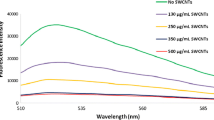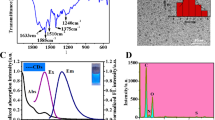Abstract
A novel visual detection mode is proposed to improve the detection sensitivity for the determination of ochratoxin A (OTA). The mode is based on aptamer recognition and the signal amplification of rolling circle amplification (RCA) products self-assembled DNA hydrogel. Moreover, gold nanoparticles (AuNPs) were directly assembled inside the DNA hydrogel by adjusting the padlock probe sequences to achieve a stronger binding force between the DNA hydrogel and AuNPs; this avoids the need for modification of AuNPs with DNA sequences. In the presence of OTA, DNA hydrogel is formed. With higher concentrations of OTA, a larger amount of DNA hydrogel is formed. When AuNPs are added to the DNA hydrogel, AuNPs can be enclosed inside the DNA hydrogel. With more DNA hydrogel, there is less AuNPs in the supernatant. Thus, the absorbance of the supernatant is anti-correlated with the concentration of OTA. After optimization of the experimental conditions, the change in the absorbance of the supernatant was linearly correlated with the concentration of OTA, in the range 0.05 to 10 ng/mL; the limit of detection was 0.005 ng/mL. The good specificity of the developed biosensor was confirmed in the presence of other mycotoxins that are coexistent with or analogues of OTA. By comparing the developed method with the ELISA method, the accuracy and stability of this new method were also verified, with good performance obtained in real samples.
Graphical abstract

Diagram of the principle of the colorimetric aptasensor for OTA detection based on rolling circle amplification product self-assembled DNA hydrogel.





Similar content being viewed by others
References
Tao YF, Xie SY, Xu FF, Liu AM, Wang YX, Chen DM, Pan YH, Huang LL, Peng DP, Wang X, Yuan ZH (2018) Ochratoxin A: toxicity, oxidative stress and metabolism. Food Chem Toxicol 112:320–331
el Khoury A, Atoui A (2010) Ochratoxin A: general overview and actual molecular status. Toxins 2(4):461–493
Pfohl-Leszkowicz A, Manderville RA (2007) Ochratoxin A: an overview on toxicity and carcinogenicity in animals and humans. Mol Nutr Food Res 51(1):61–99
(2006) European Commission Regulation Setting maximum levels for certain contaminants in foodstuffs. No. 1881/2006 of 19 December 2006 Off J Eur Union 364:5–24
Suea-Ngam A, Deck L-T, Howes PD, deMello AJ (2020) An ultrasensitive non-noble metal colorimetric assay using starch-iodide complexation for ochratoxin A detection. Anal Chim Acta 1135:29–37
Zhu H, Liu C, Liu X, Quan Z, Liu W, Liu Y (2021) A multi-colorimetric immunosensor for visual detection of ochratoxin A by mimetic enzyme etching of gold nanobipyramids. Microchim Acta 188(3):62
Liu M, Li X, Li B, Du J, Yang Z (2020) A fluorometric aptamer-based assay for ochratoxin A by using exonuclease III-assisted recycling amplification. Microchim Acta 187(1)
He Y, Tian F, Zhou J, Jiao B (2019) A fluorescent aptasensor for ochratoxin A detection based on enzymatically generated copper nanoparticles with a polythymine scaffold. Microchim Acta 186(3):199
Savastano ML, Losito I, Pati S (2016) Rapid and automatable determination of ochratoxin A in wine based on microextraction by packed sorbent followed by HPLC-FLD. Food Control 68:391–398
Ding Y, Shang H, Wang X, Chen L (2020) A SERS-based competitive immunoassay for highly sensitive and specific detection of ochratoxin A. Analyst 145(18):6079–6084
Nagahara S, Matsuda T (1996) Hydrogel formation via hybridization of oligonucleotides derivatized in water-soluble vinyl polymers. Polymer Gels Netw 4(2):111–127
Kouwer PHJ, Koepf M, Le Sage VAA, Jaspers M, van Buul AM, Eksteen-Akeroyd ZH, Woltinge T, Schwartz E, Kitto HJ, Hoogenboom R, Picken SJ, Nolte RJM, Mendes E, Rowan AE (2013) Responsive biomimetic networks from polyisocyanopeptide hydrogels. Nature 493:651–655
Li J, Mo L, Lu C-H, Fu T, Yang H-H, Tan W (2016) Functional nucleic acid-based hydrogels for bioanalytical and biomedical applications. Chem Soc Rev 45(5):1410–1431
Song JY, He WT, Shen H, Zhou ZX, Li MQ, Su P, Yang Y (2019)Self-assembly of a magnetic DNA hydrogel as a new biomaterial for enzyme encapsulation with enhanced activity and stability. Chem Commun 55(17):2449–2452
Mao Y, Li JX, Yan JM, Ma YL, Song YL, Tian T, Liu X, Zhu Z, Zhou LJ, Yang CY (2017) A portable visual detection method based on a target-responsive DNA hydrogel and color change of gold nanorods. Chem Commun 53(47):6375–6378
Liao WC, Lilienthal S, Kahn JS, Riutin M, Sohn YS, Nechushtai R, Willner I (2017)pH- and ligand-induced release of loads from DNA-acrylamide hydrogel microcapsules. Chem Sci 8(5):3362–3373
Chang YY, Li MY, Wu ZY, Zhuo Y, Chai YQ, Xiao Q, Yuan R (2018) Homogeneous entropy catalytic-driven DNA hydrogel as strong signal blocker for highly sensitive electrochemical detection of platelet-derived growth factor. Anal Chem 90(13):8241–8247
Liu RD, Huang YS, Ma YL, Jia SS, Gao MX, Li JX, Zhang HM, Xu DM, Wu M, Chen Y, Zhu Z, Yang CY (2015) Design and synthesis of target-responsiveaptamer-cross-linked hydrogel for visual quantitative detection of ochratoxin A. ACS Appl Mater Interfaces 7(12):6982–6990
Si Y, Li L, Wang N, Zheng J, Yang R, Li J (2019) Oligonucleotide cross-linked hydrogel for recognition and quantitation of MicroRNAs based on a portable glucometer readout. ACS Appl Mater Interfaces 11(8):7792–7799
Li YS, Ma YL, Jiao XY, Li TY, Lv ZH, Yang CJ, Zhang XJ, Wen YQ (2019) Control of capillary behavior through target-responsive hydrogel permeability alteration for sensitive visual quantitative detection. Nat Commun 10:1036
Geng JH, Yao C, Kou XH, Tang JP, Luo D, Yang DY (2018) A fluorescent biofunctional DNA hydrogel prepared by enzymatic polymerization. Adv Healthcare Mater 7(5):1700998
Huang YS, Xu WL, Liu GY, Tian LL (2017) A pure DNA hydrogel with stable catalytic ability produced by one-step rolling circle amplification. Chem Commun 53(21):3038–3041
Yan YC, Li J, Li WH, Wang Y, Song WL, Bi S (2018) DNA flower-encapsulated horseradish peroxidase with enhanced biocatalytic activity synthesized by an isothermal one-pot method based on rolling circle amplification. Nanoscale 10(47):22456–22465
Xie SB, Zhang J, Teng LM, Yuan W, Tang Y, Peng Q, Tang QC (2019) Electrochemical detection of lipopolysaccharide based on rolling circle amplification assisted formation of copper nanoparticles for enhanced resistance generation. Sensors Actuators B-Chem 301:127072
Li X, Cui Y, Du Y, Tang A, Kong D (2019)Label-free telomerase detection in single cell using a five-base telomerase product-triggered exponential rolling circle amplification strategy. ACS Sensors 4(4):1090–1096
Liu X, Song M, Hou T, Li F (2017)Label-free homogeneous electroanalytical platform for pesticide detection based on acetylcholinesterase-mediated DNA conformational switch integrated with rolling circle amplification. ACS Sensors 2(4):562–568
Liu M, Zhang Q, Kannan B, Botton GA, Yang J, Soleymani L, Brennan JD, Li Y (2018)Self-assembled functional DNA superstructures as high-density and versatile recognition elements for printed paper sensors. Angewandte Chem-Int Edition 57(38):12440–12443
Hao L, Wang W, Shen X, Wang S, Li Q, An F, Wu S (2020) A fluorescent DNA hydrogel aptasensor based on the self-assembly of rolling circle amplification products for sensitive detection of ochratoxin A. J Agric Food Chem 68(1):369–375
Funding
This work was partly supported by the Science and Technology Innovation Action Plan of Shanghai (20392001600), the Natural Science Foundation of Shanghai (18ZR1409500), and the Technology R&D Program of Suzhou (SNG2018044).
Author information
Authors and Affiliations
Corresponding author
Ethics declarations
Conflict of interest
The authors declare that they have no conflict of interest.
Additional information
Publisher’s note
Springer Nature remains neutral with regard to jurisdictional claims in published maps and institutional affiliations.
Supplementary information
ESM 1
(DOCX 183 kb)
Rights and permissions
About this article
Cite this article
Hao, L., Liu, X., Xu, S. et al. A novel aptasensor based on DNA hydrogel for sensitive visual detection of ochratoxin A. Microchim Acta 188, 395 (2021). https://doi.org/10.1007/s00604-021-05000-y
Received:
Accepted:
Published:
DOI: https://doi.org/10.1007/s00604-021-05000-y




